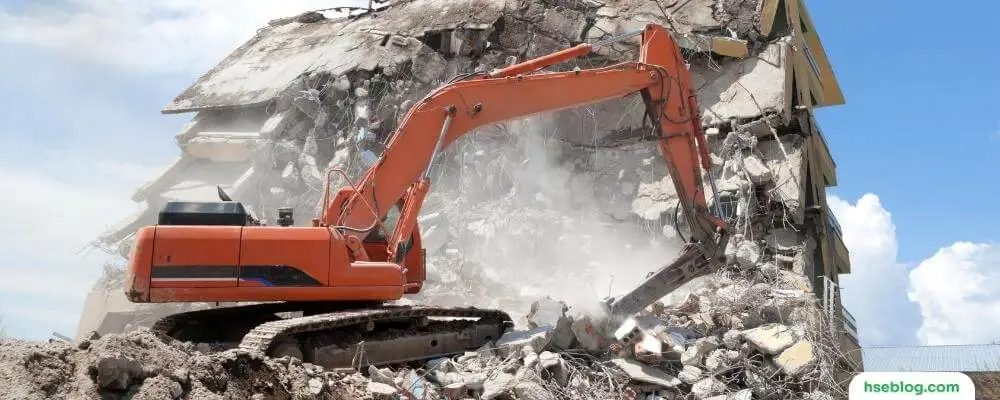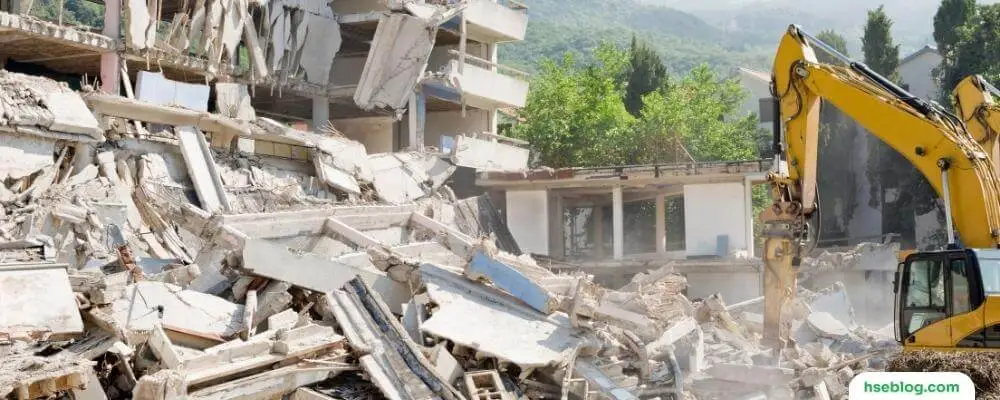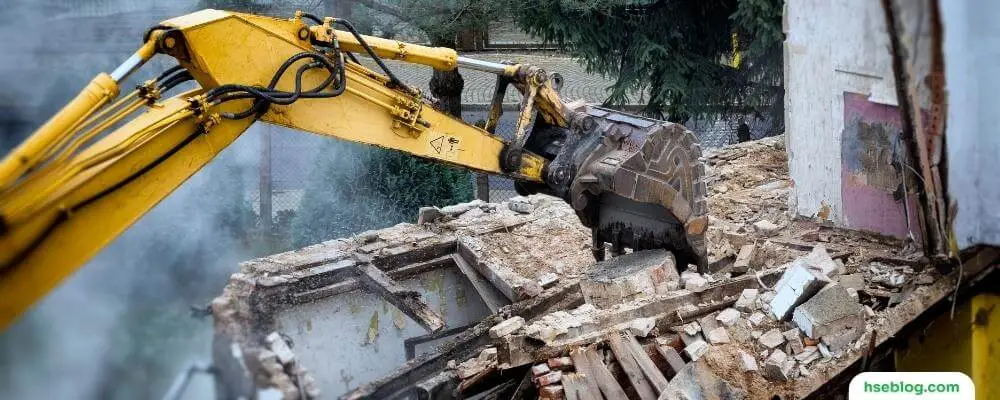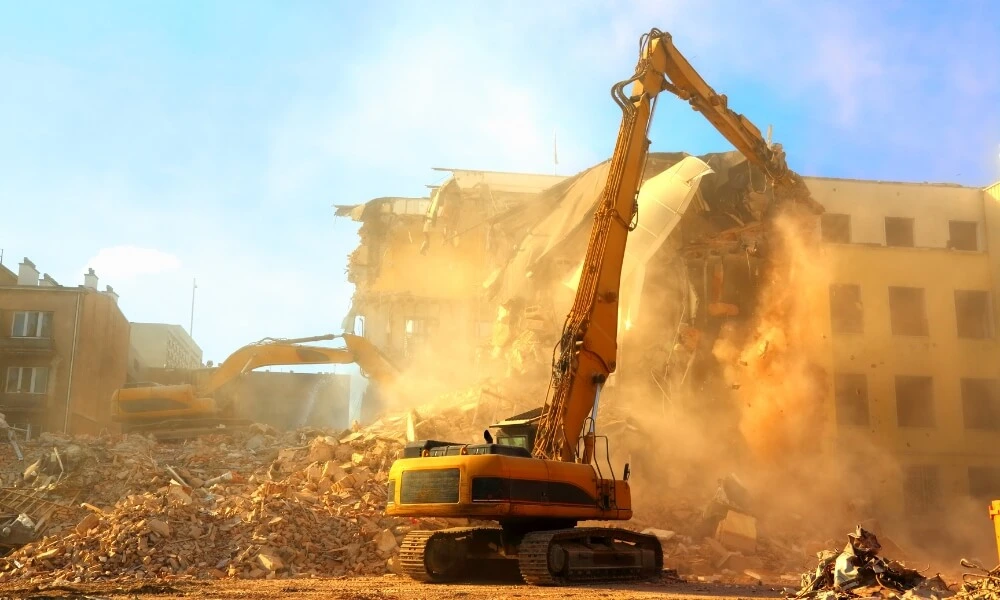Demolition projects are a crucial aspect of the construction industry, but they come with inherent risks that must be carefully managed to ensure the safety of workers. This blog will explore 16 common demolition hazards and discuss effective control measures to mitigate these risks. Understanding and addressing these hazards can create a safer working environment and protect everyone involved in demolition projects.
Demolition sites present various hazards, including falls from height, falling debris, structural instability, dust and fumes, hazardous materials, and equipment-related accidents. Proper planning, training, and safety measures are essential to mitigate these risks. This blog aims to provide insights into these hazards and equip readers with the knowledge to promote safety on-site, fostering a culture of caution and responsibility in the construction industry. By implementing the recommended control measures, we can minimize accidents and create a secure environment for demolition workers.
What is Demolition?
Demolition work is tearing down and removing old buildings or structures. This type of work can be very dangerous, so it’s important to be cautious and follow safety guidelines. Demolition workers use various tools to break apart concrete, metal, and other materials. They also use bulldozers and other heavy machinery to knock down buildings. The debris from demolition projects is typically taken to landfills or recycling facilities.
Working as a demolition worker can be a physically demanding job. Workers must be able to lift heavy objects and use power tools safely. They also need to have good coordination and balance. Demolition work can be done indoors or outdoors, so workers must be comfortable working in various environments. Some demolition workers specialize in a particular type of work, such as breaking down concrete walls or removing asbestos from buildings.
Demolition is one of the most hazardous construction operations, responsible for more deaths and major injuries than any other activity. The CDM Regulations control the management of demolition work.

Demolition Hazards And Control Measures
Demolition work involves many of the same hazards that arise during other construction activities. Still, it includes additional hazards due to unknown factors such as changes to the building’s structure over time, hidden materials, or inappropriate methods used during original construction. Here are 16 common hazards during demolition and their corresponding control measures:
1. Falls From Height
Falls from height are a predominant risk in demolition activities, representing one of the most recurrent hazards because workers frequently interact with tall structures or contend with unstable surfaces. These accidents can result in serious injuries or, in many cases, prove fatal. To prevent such occurrences, it’s crucial that extensive measures are put into place.
One of the primary steps involves equipping workers with appropriate fall protection gear. This gear typically consists of harnesses and lanyards designed to arrest falls by securing the wearer to a solid anchor point, mitigating the potential for freefall. These safety measures ensure that workers remain attached to the structure even if they lose balance, significantly reducing the risk of fall-related injuries or fatalities.
2. Falling Debris
Falling debris is a significant risk during demolition operations, as dislodged pieces of the structure can fall unpredictably and inflict severe harm on workers. This danger is particularly acute when heavy materials or sharp objects are involved. To mitigate this risk, adherence to proper safety protocols is essential. Personal Protective Equipment (PPE), including hard hats and safety glasses, is necessary to safeguard workers from injuries.
Additionally, implementing protective measures around the site, such as debris netting or catch platforms, can minimize the danger by containing or diverting falling objects. These nets or platforms absorb the energy of falling debris, halting their descent and thus protecting those on the ground level. However, regular inspection and maintenance of these protective installations are critical to ensure their effectiveness throughout demolition.
3. Premature Collapse Of Structure
The premature collapse of a structure during demolition is a severe hazard that can lead to catastrophic accidents, potentially causing injury or death to workers and bystanders. This may occur due to improper planning, sequence of demolition, or inadequate support to the structure during the process. Insufficient knowledge about the building’s structure or unexpected alterations can also lead to premature collapse. To mitigate this risk, detailed surveying and planning are crucial.
Every step of the demolition must be carefully orchestrated to maintain structural stability. Furthermore, temporary supports or bracing systems may be installed to reinforce the structure during the demolition. Adherence to local regulations and safety guidelines and consultation with structural engineers can also be instrumental in preventing premature collapses. Another vital safety measure is regularly monitoring the demolition process to identify and rectify any potential stability issues.
4. Dust & Fumes
Dust and fumes pose significant hazards during demolition activities, potentially leading to respiratory complications and visibility issues. When a structure is demolished, various materials can be pulverized, releasing microscopic particles into the air. These can contain harmful substances such as silica, asbestos, or other toxins, depending on the materials used in the building. Furthermore, the use of certain demolition equipment can produce dangerous exhaust fumes.
To mitigate these risks, dust suppression methods like water sprays or misting systems can be used to reduce airborne particulates. For fumes, proper ventilation is crucial, especially in enclosed spaces. Workers should also wear appropriate respiratory protective equipment (RPE) to prevent inhalation of harmful particles or gases. Additionally, regular air quality monitoring can help ensure the effectiveness of these control measures and enable timely adjustments if needed.

5. The Silting Up Of Drainage Systems By Dust
One of the lesser-known hazards associated with demolition work is the silting up of drainage systems by dust. When workers demolish a structure, the dust can get into the drainage system and clog it up. This can cause serious flooding problems if the drainage system is not cleared out in a timely manner.
To avoid this, it’s important to be aware of the hazard and take the necessary precautions to prevent dust from entering the drainage system. This includes using proper ventilation and keeping the area around the drainage system clear of debris.
6. The Problems Arising From Spilt Fuel Oils
Spilled fuel oils during demolition work pose serious safety and environmental risks. Such spills can potentially ignite, leading to fire or even explosion, particularly if they come into contact with hot surfaces or electrical equipment. Additionally, spills can lead to soil and water contamination, posing environmental hazards and potential legal implications. Strict protocols must be followed to prevent such issues when handling fuel oils.
Firstly, machinery should be regularly inspected for leaks and properly maintained. The area around fuel tanks and machinery should be kept clean and debris-free to reduce the chances of accidental ignition. Furthermore, appropriate containment methods should be used during fuel storage and transportation to avoid spills. These methods could include secondary containment systems such as bunds or drip trays. In a spill, having an emergency response plan, including spill kits and fire extinguishers, can help manage the situation swiftly and effectively.
7. Manual Handling
Manual handling, involving the moving, lifting, carrying, pushing, or pulling of objects, presents another common hazard during demolition activities. Workers may be required to handle heavy or awkward materials, potentially leading to physical injuries, including musculoskeletal disorders, strains, sprains, or even more serious injuries if a worker trips or falls while handling an item.
To mitigate these risks, employers should endeavor to minimize the need for manual handling by using mechanical aids such as forklifts or cranes. When manual handling is unavoidable, training is critical to ensure workers know the correct lifting techniques and understand the risks. The use of personal protective equipment, such as gloves and safety footwear, can also help reduce injury.
8. Asbestos And Other Hazardous Substances
Another hazard to be aware of is the presence of asbestos and other hazardous substances. Many older buildings contain asbestos, which can release harmful fibers into the air if disturbed. Many building materials may also contain other hazardous substances, such as lead.
To protect yourself from asbestos and other hazardous substances, it’s important to wear proper personal protective equipment, such as a respirator. Additionally, you should try to work in a well-ventilated area to avoid inhaling harmful fibers. If you suspect that a building contains asbestos or other hazardous substances, you should have it inspected by a qualified professional before starting any demolition work.

9. Noise And Vibration
Another hazard associated with demolition is noise and vibration from heavy plants and equipment. The machinery used in demolition work can be very loud, and its vibrations can harm your health.
To protect yourself from noise and vibration, it’s important to wear proper hearing protection, such as earplugs or earmuffs. Additionally, you should try to work in a well-ventilated area to reduce the noise level. If the noise level is too loud, you may need to use sound-blocking earmuffs or earplugs.
10. Electric Shock
One of the most serious hazards associated with demolition work is electric shock. This can occur when workers come into contact with live electrical wires or equipment. Electric shock can lead to serious injuries or even death, so it’s important to take the necessary precautions to avoid it.
Some ways you can do this include de-energizing electrical equipment before working on it, wearing proper personal protective equipment, and avoiding areas with water or dampness. You should also be cautious when working near electrical wires or equipment. If you are unsure how to safely work with electricity, you should consult a qualified electrician.
11. Fires And Explosions
Another hazard associated with demolition is fires and explosions from flammable and explosive substances. Many chemicals and gases used in demolition are highly flammable and can easily catch fire or explode if improperly handled.
To protect yourself from fires and explosions, it’s important to be aware of the hazards of the substances you use and take the necessary precautions. You can do this by reading the labels on all containers, keeping flammable substances away from heat or flames, and using proper ventilation when working with volatile substances. Additionally, you should always have a fire extinguisher handy in an emergency.
12. Smoke From Burning Waste
Another hazard associated with demolition is smoke from burning waste timber and materials. When demolition work is being done, a lot of waste timber and materials are often burned. This can release harmful toxins into the air, harming your health.
Wearing a respirator or face mask is important to protect yourself from smoke. Additionally, you should work in a well-ventilated area to avoid inhaling harmful toxins. If the smoke is too dense, you may need to leave the area and seek fresh air.

13. Pneumatic Drills and Power Tools
Another hazard associated with demolition work is pneumatic drills and power tools. These tools can generate a lot of noise and vibration, harming your health. They can also create dust and flying debris, which can be dangerous if inhaled.
To protect yourself from pneumatic drills and power tools, it’s important to wear proper hearing protection, such as earplugs or earmuffs. Additionally, you should wear a dust mask or respirator to avoid inhaling harmful particles. Additionally, you should try to work in a well-ventilated area to reduce the risk of exposure to harmful toxins.
14. The Existence Of Services
Another hazard associated with demolition work is the existence of services, such as electricity, gas, and water mains. These services can be damaged during demolition, leading to serious injuries or death.
To protect yourself from this hazard, it’s important to be aware of the location of all services before starting work. Additionally, you should always call the utility company to have the service disconnected before starting work. Additionally, you should never try to disconnect the service yourself.
15. Collision With Heavy Plant Or Machinery
Another hazard associated with demolition is colliding with heavy plants or machinery. Demolition work often involves the use of large pieces of machinery, such as excavators and bulldozers. If you are not careful, you could easily be hit by one of these machines.
To protect yourself from this hazard, it’s important to be aware of the location of all plants and machinery at all times. You should never walk in front of or behind a moving machine. Additionally, you should always wear bright clothing to be more visible to the machinery operators.
16. Plant and Vehicles Overturning
Another hazard associated with demolition work is plant and vehicle overturning. This can happen if the plant or vehicle is not properly secured or the ground is too soft. If a plant or vehicle overturns, it can cause serious injuries or death.
To protect yourself from this hazard, it’s important to be aware of the location of all plants and vehicles at all times. Additionally, you should never walk under or around a plant or vehicle that is being lifted. Additionally, you should always wear bright clothing to be more visible to the machinery operators.

Things to Know Before Starting the Demolition
Before any work is started, the full site investigation will help to determine the potential hazards and risks associated with the demolition work. This will help to ensure the safety of the workers and the public.
The investigation should cover the following topics:
- Before beginning demolition, it is important to investigate the construction details of the buildings that will be demolished and of any neighboring structures. This will help ensure the demolition is carried out safely and without damaging nearby buildings.
- Any hazardous materials present, such as asbestos or lead. This is important to ensure the safety of those doing the demolition and to avoid spreading any hazardous materials. The location of any underground or overhead services (water, electricity, gas, etc.);
- Investigating the area for underground cellars, storage tanks, or bunkers is important. This is especially important if flammable or explosive substances were previously stored in these areas. This will help avoid any accidents or damage during the demolition process.
- It is important to investigate the location of any public thoroughfares adjacent to the structure or building. This will help ensure the work can be carried out safely and without disrupting the surrounding area.
- The type of foundation the building is built on (e.g., slab, footing, etc.). This is important as it will affect how the demolition is carried out. For example, a building with a footing foundation must have the foundations excavated before the demolition can begin.
- The height of the building. For example, a tall building will need to be demolished from the top down, while a shorter building can be demolished from the bottom up.
Conclusion
The demolition industry presents numerous hazards that require diligent management and effective control measures. We can create a safer working environment by prioritizing safety protocols, such as providing appropriate protective gear, maintaining structural stability, addressing dust and fume exposure, and minimizing manual handling risks. Additionally, being aware of hazardous materials, managing noise and vibrations, and taking precautions against electrical hazards, fires, and services are crucial for worker safety. Through these measures, we can mitigate risks, minimize accidents, and foster a safety culture in the construction industry.

